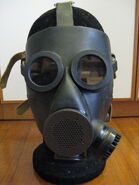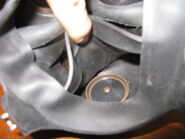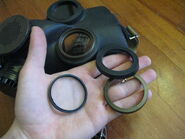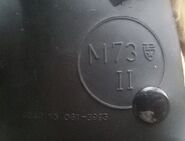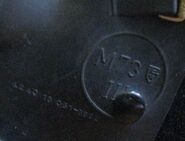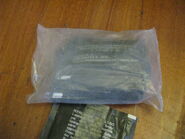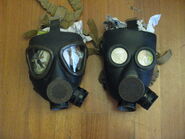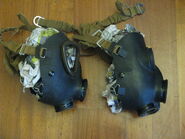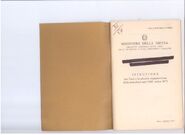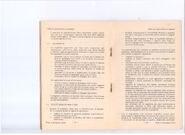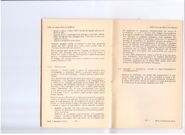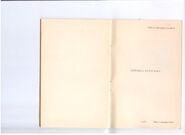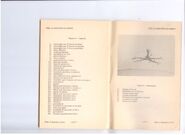The M73 was the standard Italian optical gas mask, succeeding the O.39 and O.41 in this role, which were used until the 1970s. Its design is heavily based on the M59, sharing most of its hardware and kit.
Mask overview[]
The M73 mask was composed of the following parts:
- faceblank
- eyepieces
- internal dividing septum
- phonic device (diaphragm)
- exhale assembly
- intake assembly
- head-harness
The faceblank is made of black, semi-rigid rubber. It is composed of the following:
- the housings for the eyepieces, the exhale assembly, the intake assembly and the phonic device
- two press-buttons to attach the septum
- strap attachments
The faceblank has a peripheral seal that allows an easier seal to the user's face. On the left side of the faceblank, there is the main marking, which shows the name of the mask, the size (1 to 3 in roman number), the producer's logo and the unified code relative to the size. On the other side, there is a serial number marking.
The septum, made of black rubber, is attached to the facepiece using the aforementioned press-buttons and by the connection to the housing of the exhale assembly and to the phonic device. It's shaped in such a way to create two chambers, one for the eyes and one for the mouth and nose. The upper part of the septum has a peripheral seal to adhere to the nose and cheeks to avoid fogging of the eyepieces. Adherence to the nose is assured by a steel clamp that keeps the shape of the septum. In the middle, there are 4 holes through which inhaled air passes. The shaping of the septum creates what effectively works as two Tissot ducts that start from the intake valve and end on the eyepieces.
The straps are 5, one at the front, two at the temples and two at the cheeks. The top strap, which is rigid, is attached through a buckle to a strip of rubber atop the facepiece and another buckle on the nape pad, with multiple holes to adjust the length. The temple straps are attached in a similar way, but in this case, the buckle is attached through a cloth piece (identical in material to the straps) attached to the facepiece through a loop in the rubber. The cheek straps are attached through metal hooks permanently inserted in the rubber. All the elastic parts (on the 4 lower straps) are made of rubber straps enclosed in a canvas sheath that protects the aforementioned and prevents them from being stretched too much and breaking. The nape pad is composed of a rectangular canvas piece with rubber inserted inside and it's attached permanently to the lower 4 straps; it has a buckle at the top to connect to the top strap and a canvas loop on the connection with the right temple strap. The nape pad and the straps are an assembly that can be replaced with any other strap assembly used by the Army since 1931.
The eyepieces are composed of two optically neutral Triplex glass discs, replaceable with corrective lenses. Those discs are each engulfed in a gasket, placed in the dedicated housing and secured with a threaded aluminium piece, which is covered with a rubber cap.
The phonic device (voice diaphragm) is made of a simple transparent plastic sheet housed in its dedicated assembly with a rubber gasket ensuring the seal. The assembly is fixed on the mask using zinc wire and black tape.
The exhale assembly is located on the left side of the facepiece. It's made up of the round plastic housing, its cover and the valve itself. The exhale valve is a simple rubber disc with a rubber stud attached to it that keeps it attached to the housing. The cover is also made of plastic, it can rotate on one axis and can be removed with sufficient force. The assembly is fixed on the mask using zinc wire and black tape.
The intake assembly is composed of an aluminium threaded piece that has a rubber gasket to seal with the hose and an "x" shaped crossbar section that supports the intake valve, which is a rubber disc with a hole in the middle.
Kit[]
Regular issue kit[]
The M73 was always issued with the following:
- Hose
- M66 bag
- M.58 filter
The hose is made of black rubber, it's suitably corrugated to avoid being crushed and to allow it to extend. It has a thread for each end fixed on the mask using zinc wire and black tape. The female thread is used to connect the filter, while the male one connects to the mask. Both threads house a gasket.
The M66 bag is of a cylindrical shape with various features. At the bottom of the bag, there's a hole that allows the user to keep the filter in the bag and connect it through the mask with a hose, which is always the case with the M73. A small strap near the bottom is to be tied to the hip of the user so to avoid having the bag wobbling while running or overcoming obstacles. At the front of the bag, there is a large pocket that is used to carry the M.58 protective sheet. On the same pocket, there is a smaller pocket for storing the complementary NBC set, and in the middle of this last pocket, there's a transparent pocket for showing the tag. On the sides, there are two identical pockets that are both used for storing reclaiming powder packages. The bag is closed with a button and a tear-off tab, and it's carried using a large adjustable strap and 2 hooks at the top that are supposed to go around the belt.
The M73 used an M.58 filter, which was at the time the standard gas mask canister for the Italian Army.
Additional kit[]
When necessary, the M73 was issued the following NBC equipment:
- M58 protective sheet
- Several M75 reclaiming powder packages
- Complementary NBC set
The M58 protective sheet was meant to be a quick way to protect the soldier in case of an unexpected NBC attack. It's made of a plastic sheet with pockets for hands and feet and it's stored in a plastic package with its instructions, visible even when the package hasn't been opened.
The reclaiming powder packages were used to remove NBC agents from infected parts of an NBC suit or directly from the skin. Each dose was 10 grams in weight and it was contained in a small packet.
The complementary NBC set was a plastic case that contained the following:
- 3 atropine autoinjectors
- 1 antishock powder packet
- 1 sachet containing 9 tablets of glafenine painkillers
- 1 burn-curing packet
Use[]
The M73 was a gas mask used by everyone who had to use optical devices frequently such as artillerymen, gunners and soldiers in bunkers. The M73 was also issued to those who had to wear corrective lenses, as the optically neutral discs could be replaced with corrective ones (with up to 6 diopters).
Comparisons[]
Manual[]
The M73 manual wasn't issued with each kit but with the military body that had to use these masks.

